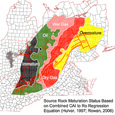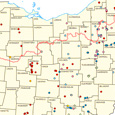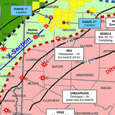Shale Gas Q&A with Thomas Murphy, Penn State Extension
Tuesday, October 8, 2013

Thomas Murphy is co-director of the Penn State Marcellus Center for Outreach and Research. He has more than 25 years of field experience with landowners, government agencies and public officials.
SGR: What’s the most common question or concern people have about the shale gas boom?
TM: The most common question, it could also be labeled as a concern, is the impact from any aspect of the drilling process on water quality.
SGR: What’s the biggest misconception that people have about the process and the industry itself?
TM: When we think about the range of questions we get about drilling and hydraulic fracturing. What will the impact be to water? What will that impact be in the short-term and the long-term? One of the misconceptions we see is that there is migration of fluids from depth. That is something that we do not see. Something else is we break that question down. We think of methane migration or spillage at the surface.
What we actually see as the number one true concern is that there is potential for spillage at the surface. That’s the place where we’ve seen regulation protocol changes, we’ve seen more inspections being done, we’ve seen best management practices change over time.
SGR: What are some of the changes in practices that you’ve noticed over the last few years?
TM: We’ve noticed a reduction in spills at the surface because of the deployment of berms and multiple layers, redundant layers, secondary and tertiary systems to prevent spills, or to allow the collection of spills, if one should occur, on the sight.
One of the misperceptions is that spills are common and large scale. What we see from the numbers is spills are not nearly as prevalent as some might think. And typically they’re much smaller scale. We’re talking about something measured in single-digit gallons compared to truck loads of something.
The other thing we see is tertiary systems around tanks, where there is higher potential of either a leak or a spill. We see a lot more of that and regulation is quickly making that the standard.
SGR: What exactly is Penn State currently studying in regards to the hydraulic fracturing process?
TM: We look at a wide range of things from above ground considerations, like the socioeconomic considerations within communities, we look at things dealing with the healthcare system, education and workforce. We also look below ground.
We also look at water-based considerations. The maximizing of water, where water is being sourced, different types of impaired waters that can be used, we think about acid mine drainage or water coming from industrial processes. We think about how those waters can be used more efficiently.
We also study the purely down-hole engineer-type processes to make them more effective. All the way down to proppants and the sourcing of proppants. Even recycling glass, industry waste, into proppants. So instead of mining new sand deposits, we’re looking at utilizing some of the byproducts that are already in the market place.
SGR: What are some of the socioeconomic impacts? Some of the early findings?
TM: We’ve looked at what locations within the broader business communities are being impacted in either a positive or negative way. Certainly there’s some local businesses that are clear winners in the development of natural gas. Local business that might be catering or have services that are directly applicable to this industry as it’s expanding.
But, at the same time, are there businesses that are impacted in a negative way? Can they mitigate some of that potential downside?
SGR: What kind of businesses would be impacted in a negative way?
TM: If you have specialized businesses coming in that might be taking business from a local. The local may not be willing to change their business model. Then you see another business that is willing to deal with the unusual hours, or some of the special aspects of a product line.
We also see shifts. At one time you might see a positive impact, but as drilling slows in one area, a business that might have ramped up beyond what’s sustainable, then as drilling plateaus in an area, then that model might not be the same.
One thing to keep in mind as we try to bring several of these points together, is there’s a number of layers of geology that companies are looking at. The potential for development could be for a very long period of time. Managing expectations relative to workforce and goods and services is needed.
SGR: Ohio is believed to be largely in the exploration phase moving towards midstream. In what part of the timeline is Pennsylvania?
TM: In Pennsylvania the perception is that we’re somewhere near 10 percent or less of the potential wells that could be drilled have been drilled. That said, there’s still a lot of midstream to be built. Of the 7,000 Marcellus wells that have been drilled, roughly 2,000 of them are not online yet.
SGR: You’re saying there’s potential for 70,000 Marcellus wells in Pennsylvania?
TM: Most voices in that discussion say there’s the likely number is north of that.
Keep in mind that when that number is being said, that there’s not going to be 70,000 well pads. You can have 10, 12, whatever number of wells on an individual pad.
We were looking at a number for Bradford County, the county that has the most number of Marcellus wells drilled in Pennsylvania right now. It’s also the highest producer of Marcellus shale gas in the state, at the moment. Roughly 28 percent of the county is now held by production, or in some level of production.
SGR: So 28 percent of the acreage in Bradford county is leased or in production?
TM: It would appear, yes.
SGR: What’s one thing Ohio can learn from Pennsylvania? What’s something that came up that Pennsylvania didn’t expect?
TM: There’s several things here. One is good planning. Trying to get hands around what the development of shale would look like. Certainly from a positive, we look at the economic benefits. We think about trying to mitigate any environmental risk. Also think about water and the sourcing of water, the access to water and also water remediation. Where’s it going to go?
The other considerations I would throw in there is road impacts. Restoring roads or rehabilitation roads or reconditioning roads, before the impact is heavy from industry.
We’re seeing in Pennsylvania roughly $500 million dollars has been spent by the industry to restore or recondition roads.
We also need to think about pipeline development and pipeline placement. Pipelines that are going diagonally out across a big property that might be right next to town. The use of that property years from now could be different, but that pipeline would still be there. That could impede or impact the use of that property over time.
Placement of pipelines as often as possible near boundaries or natural features that would allow the development of that property for some other use.
SGR: What are some of the negative impacts the industry has had on Pennsylvania? What are some of the negative impacts Ohioans can expect?
TM: One would be workforce. We saw initially that much of the workforce wasn’t coming from the area. There’s definitely an issue that needs resolved there. That would be one that I would identify right up from.
The roads started as a negative impact, but since has been completely turned around.
Another that I would look at it the placement of infrastructure. We can also consider things like compression that produce noise.
I would also throw in there housing issues. Is there enough housing in areas where development is occurring? We’re finding, in some cases, that in rural areas the competition for housing that’s there can increase rents pretty dramatically.
There’s also concerns about water. What impact is there to water? Make sure there’s baseline data gathered on water supplies, public and private supplies.
SGR: What do you think Pennsylvania’s shale gas landscape will look like in 5-10 years?
TM: I think from an economic standpoint, we’re already seeing considerable impacts to workforce development. We’re also seeing more manufacturing coming in, that’s tied to lower energy costs and this type of energy as a feedstock.
Any kind of industry, or development, is going to have surface impacts. We need to think about planning from a comprehensive standpoint, planning for those infrastructure demands over time.




